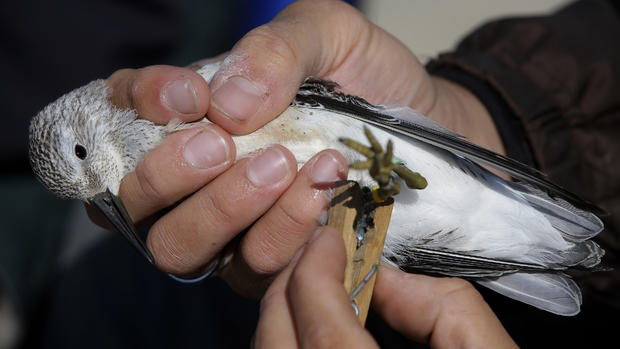Wildlife researchers track threatened shorebird
EASTHAM, Mass. On a deserted beach on Cape Cod, canons explode, firing a net into the air that descends over a group of elusive and threatened shorebirds known as red knots.
A dozen wildlife researchers emerge from hiding and sprint to transfer the prized catch into holding boxes and then to a camp nearby.
The researchers are capturing the robin-sized birds to learn more about their marathon migration routes -- a 9,300-mile flight from South America to the Arctic.
They collect feather samples as they measure, weigh and tag the birds, then fit their legs with tiny geolocators before releasing them. Biologists hope the geolocators will calculate and record the locations of the birds, helping conservation workers who will recapture them to determine their migration routes and refueling stops.
The red knot, with its salmon-colored face and breast, is already on New Jersey's endangered species list and is being considered for federal protection under the Endangered Species Act.
The population has dropped by up to 75 percent since the 1980s in some areas, according to the U.S. Fish and Wildlife Service.
The decrease is partly fueled by a drastic decline in the horseshoe crab population in Delaware Bay, a key refueling stop during their migration to the Arctic breeding grounds. The horseshoe crabs have been overfished for bait.
The birds' spring migration is timed with the release of the horseshoe crab eggs, the perfect food for a traveling red knot, according to the U.S. Fish and Wildlife Service. The red knots arrive at their stops thin, sometimes even emaciated, and eat constantly to be able to continue the trip. They can gain up to 10 percent of their body weight each day, doubling their body weight during their stopover stay.
The red knots may also be vulnerable in areas where juveniles spend their first winter away from the Arctic, said Stephanie Koch, biologist for Eastern Massachusetts National Wildlife Refuge. Identifying those locations will enable experts to evaluate if they are protected and secure enough for the species.
The plight of the red knots highlights a bigger problem. Though they have gotten much of the attention, wildlife researchers say other birds are in trouble too.
"We've been focusing on the knot because there's big migration, this is a flashy shorebird, but 70 percent of shorebird species are in decline," said Lawrence J. Niles, a wildlife biologist. "It's the stopovers. ... If they don't have them, then they either can't make it down or can't make it back."

